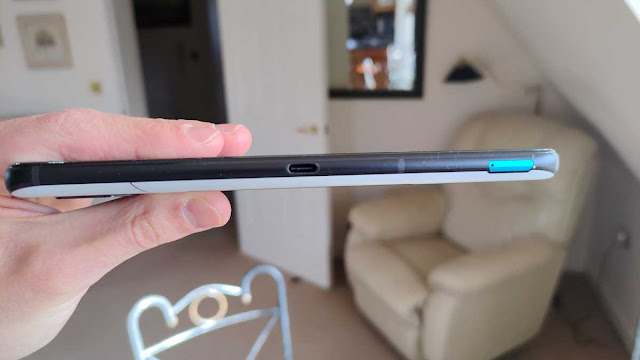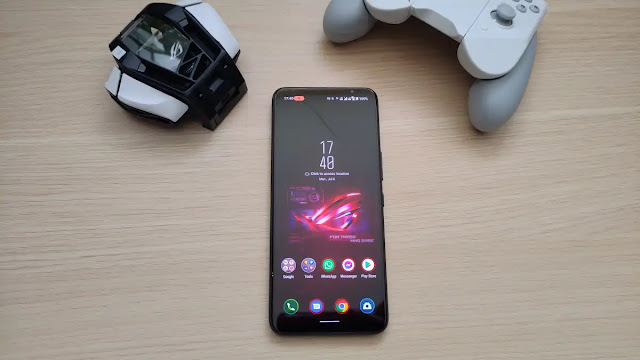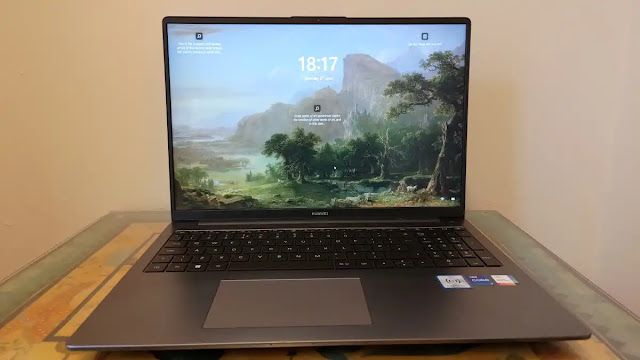Want the absolute best mobile gaming experience? This is the phone to buy.
Pros
- Class-leading performance
- Gorgeous 165Hz OLED screen
- Superb battery life
- Impressive speakers
Cons
- Expensive
- No built-in fan
- Heavy and bulky
Our Verdict
Gaming phones are a relatively modern concept, with the first handsets arriving just five years ago. Several brands have been vying for your attention since then, including Razer, Black Shark and Red Magic.
But it’s Asus that has emerged as the market leader, going above and beyond what you’d expect from any phone. However, ROG (Republic of gamers) Phones are typically more expensive than rival handsets, so it’s not always an obvious choice.
When it comes to the ROG Phone 6 Series, things get even more complicated. There are regular and Pro models to choose from, with the latter reviewed here.
Does it do enough to justify the premium price tag, or would paying less still get you everything you want from a gaming phone? I spent a few weeks with 6 Pro to find out.
Design And Build
- Premium but bulky design
- Eye-catching gamer aesthetic
- Secondary display has limited functionality
The ROG Phones have never tried to hide the fact that they are gaming phones, and that’s no different here. Asus has stuck with a bulky, imposing design for the 6 Pro, in the knowledge that it’ll not be to everyone’s tastes.
A handset that weighs 239g might also put people off, although it’s not much heavier than the Galaxy S22 Ultra (229g). Indeed, I had no problem holding the phone for long periods, although any one-handed usage is quite uncomfortable.
That’s primarily due to a large 6.78in display, with Asus opting for small bezels rather than a notch of any kind. It gives the 6 Pro an attractive symmetry, especially when gaming in landscape mode.
Asus has put this space to good use, offering dual front-facing speakers and a 12Mp selfie camera. The latter can also be used for face unlock, but the optical in-display fingerprint scanner is generally better for convenience and security. My experience using the sensor was mostly positive, although it wasn’t quite as seamless as I’d hoped. On several occasions, I had to adjust my grip or remove excess moisture before it would work properly.
Flipping the phone over reveals that classic gamer aesthetic the ROG Phone is known for. It’s particularly apparent on the eye-catching ‘Storm White’ model I tested, but it’s also available in ‘Metal’ if you’d prefer a more muted design.
Opting for metal on the back of the phone adds to the overall weight, but makes the 6 Pro feel impressively durable. It’s also the first generation of ROG Phone with any official waterproofing rating – IPX4 – meaning it’s safe from splashes of water. You still won’t want to drop it in the pool, though, as this isn’t covered.
The other defining feature on the back of the phone is a triple rear camera module. It has a new shape and has shifted up the device slightly compared to previous ROG phones, but this a subtle change I soon forgot about. Despite it creating a slight camera bump, using the 6 Pro face up on a table isn’t an issue.
The sides of the device make it very clear which way round you should be gaming. On the right (or top, when used horizontally), you’ll find power and volume controls, alongside dual shoulder triggers. Meanwhile, the opposite side adds a second USB-C port to let you comfortably play games while charging.
The only other design feature of note is a 3.5mm headphone jack, nestled discreetly next to the other USB-C port. This becomes the top-right corner when gaming in landscape mode, which doesn’t tend to get in the way if you’re plugged in.
Display And Audio
- Stunning 165Hz OLED display
- Impressive 720Hz touch sampling
- Excellent speakers
The ROG Phone 6 Pro’s display is very similar to its predecessor. It’s still a 6.78in, 2448×1080 OLED panel, but the maximum refresh rate is now 165Hz rather than 144Hz. This is a subtle change, but brings it level with the Red Magic 7 and 7 Pro as one of the highest refresh rate phones you can buy.
The responsiveness and fluidity it offers is stunning, but most people are better off staying in ‘Auto’ mode. This can automatically move between 165Hz, 144Hz, 120Hz, 90Hz and 60Hz depending on the app or situation, saving battery life without impacting performance.
Even in everyday usage, it’s hard not to be impressed by the 6 Pro’s display. It delivers excellent detail and vibrant colours, making for an immersive viewing experience. The panel also gets impressively bright, reaching 500 nits at max brightness in testing. As a result, outdoor visibility in most conditions isn’t a problem.
Audio is something that’s often overlooked on modern smartphones, but the ROG Phone 6 Pro makes it a priority. Like the ROG Phone 5 and 5s Series, the speaker system has been designed in collaboration with audio company Dirac. Known as Dirac Virtuo, a stereo setup here combines a large front-facing speaker with the earpiece to deliver spatial audio.
Music and game sound effects are rich and full-bodied as a result, and it helps to really add to the overall experience. You also get a satisfying hit of bass, something that’s often lacking on other handsets. Of course, you can always connect Bluetooth headphones or wired audio devices via the 3.5mm jack if you’d prefer.
Specs And Performance
- Snapdragon 8+ Gen 1 and 18GB RAM
- Stellar performance, but can run hot
- 512GB non-expandable storage
The ROG Phone 6 Pro’s most notable upgrade can be found under the hood. It uses the Snapdragon 8+ Gen 1, Qualcomm’s new top-of-the-line 5G chip. At the time of writing, it’s one of only three handsets on sale to use it, but plenty more are on the way.
Performance gains compared to the regular 8 Gen 1 are minor, but you’ll notice a bigger jump compared to the earlier Snapdragon 888+ that powered the ROG Phone 5S and 5S Pro. Here, Asus pairs it with an Adreno 730 GPU and 18GB of RAM on the only configuration available.
This is arguably the most powerful phone you can buy right now, so it should come as no surprise to learn that performance is stellar. The 6 Pro handles every demanding game you can throw at it with ease, whether it’s Call of Duty: Mobile, PUBG Mobile, FIFA Mobile or Real Racing 3.
The ROG Phone 6 Pro barely breaks a sweat most of time, and it seems like the device has plenty of performance in hand. That’s even more apparent when you use it as a regular smartphone, where it feels almost ridiculously overpowered.
However, that’s not necessarily reflected in the benchmarks below, with the 6 Pro supposedly lagging behind some rivals:
With no built-in fan, the phone gets noticeably warm to the touch after just a few minutes. Asus relies on an improved thermal system to get the job done, but it’s noticeably less effective.
You can connect the optional AeroActive Cooler 6 for an instant hit of cooling, but it’s bulky and annoying to use. No wonder Asus only recommends using it when you’re gaming for longer than an hour.
While on the subject, it’s worth highlighting another accessory you can buy for the 6 Pro. The Kunai 3 Gamepad transforms the phone into a proper console via two different modes.
You can dock the controls on each side of the phone for a Switch-like experience or combine them into an Xbox-style controller that connects via Bluetooth or USB-C. Only a handful of games are supported, but playing the likes of Asphalt 9 was a lot of fun.
Battery And Charging
- 6000mAh total battery capacity
- Superb battery life, even at 165Hz
- 65W fast charging, plus extra features
Like the last four generations of ROG Phone, the 6 Pro is equipped with dual 3000mAh batteries, providing a total capacity of 6000mAh. That’s still one of the largest you’ll find in any handset, so there was no real reason to upgrade it.
Indeed, battery life is one of the phone’s key strengths. With the refresh rate set to ‘Auto’ mode, I could comfortably get a full day of moderate usage, plus an hour or two of gaming. For everyday use cases, you’re looking at closer to two days.
Internal testing backs that up. With the brightness set to a fairly typical 200 nits, I recorded 11 hours and 51 minutes in PC Mark’s battery benchmark. Rather than provide a measure of screen-on time, this aims to simulate real-world usage. It was also performed at 165Hz and without any battery saver modes turned on – changing either of these will prolong battery life even further.
When you do run out, Asus helpfully includes its 65W fast charger in the box, which can be used with either of the USB-C ports. My sample went from 0-59% in 15 minutes, then 88% by the half-hour mark. In under 45 minutes, the device was fully charged – that’s consistent with Asus’s claims.
To help prolong the battery’s lifespan, you can even set it to stop charging when it hits 80% or 90%, which is still plenty for a full day’s general usage. You can also schedule it to only charge at certain times, such as in the few minutes leading up to your alarm. There’s no wireless charging here, but this is a great substitute.
Camera And Video
- Impressive 50Mp main sensor
- Ultrawide and macro less impressive
- Decent selfie camera
The ROG Phone 6 Pro’s main focus is gaming, but it needs to be a solid regular smartphone too. In that regard, cameras are crucially important.
Interestingly, the 6 Pro uses a 50Mp main camera rather than the 64Mp one on the 5S Pro. However, a higher megapixel count rarely translates into automatically better image quality. This is an upgraded sensor, and I was impressed with the stills it produced.
That’s particularly apparent in good lighting conditions, where it produces vibrant shots brimming with detail. These aren’t quite true to life, but it means many people won’t need to edit their photos later.
It handled some tricky shadows better than expected, avoiding overexposing the background. Shots of architecture are a real strength, but it also performs well in street photography and landscape imagery. However, without a dedicated depth sensor, portrait-style shots are underwhelming. Edge detection is a real issue, although you can change the amount of background blur after the photo is taken.
It’s great to have the flexibility of an ultra-wide lens, but at 13Mp it’s a noticeable drop in quality. You can still get some pleasing shots, but many of the subtle details are lost and the sky tends to be overexposed. The 5Mp macro sense avoids some of these issues, but delivers poor close-up shots with washed-out colours.
There’s a software-based night mode too, but it doesn’t do a great job of brightening or adding detail to low-light shots.
Fortunately, the 12Mp selfie camera is much more usable. It still struggles in harsh lighting, but most of the time you’ll get a crisp shot that retains plenty of details in the background.
See a range of camera samples in the slideshow below:
On the video side, the 6 Pro can capture footage up to 8K at 24fps. But for most people, the default 1080p at 30fps will do just fine. There’s no OIS, but electronic image stabilisation on the main and ultrawide lenses helps video to remain steady most of the time.
Software And Updates
- Zen UI & ROG UI over Android 12
- Several extra tools for gamers
- Only two years of updates
On the ROG Phone 6 Pro, you’ll find a combination of Asus’ Zen UI and ROG UI skins over Android 12. Despite this, it’s surprisingly similar to the version you’ll find on Pixel phones, with rounded icon corners, the new quick settings design, and a Google Discover feed next to the home screen.
However, the ROG tweaks kick in once you turn on X Mode, Asus’ dedicated space for gaming. When activated, it’s an effective way to boost game performance and minimise the distracting effect of notifications.
The Armoury Crate companion app offers a wide range of customisation options, but most of these add little to the overall experience. A social feed known as ‘ROG Connect’ may be more useful, but only for certain people.
Once you’ve started playing, Game Genie kicks in with quick access to all the tools you’ve come to expect from gaming phones – including several different performance modes.
In terms of software updates, Asus guarantees two major versions of Android for its phones. That means the ROG Phone 6 Pro will only get Android 13 and its successor (likely Android 14), with security updates coming to an end after around 24 months.
That meets Google’s minimum recommendations, but many phone companies are much more generous these days. Considering you’re spending so much on the 6 Pro, it really should be lasting more than two years.
Price And Availability
Considering everything you’re getting here, it’s no surprise to learn that the ROG Phone 6 Pro doesn’t come cheap. There’s only one configuration available, offering 18GB of RAM and 512GB of storage for £1,099/€1,299. The phone is available to pre-order now from the Asus website in the UK and Europe, where you’ll get a free Aero Active Cooler 6. Shipping is scheduled to take place in early September.
Its price puts it firmly in flagship phone territory, and it’s the most expensive gaming phone by far. As it turns out, the regular model (from £899/€999) is the next most affordable, with the Black Shark 5 Pro and Red Magic 7 Pro significantly cheaper.
It’s also worth considering whether you really need a gaming phone. At this price, you could get an iPhone 13 Pro or Samsung Galaxy S22 Ultra, both of which offer flagship-level performance and a 120Hz refresh rate within a more well-rounded device, with much longer software support.
The ROG Phone 6 Pro is an incredible phone, but it is very expensive.
Verdict
The ROG Phone 5S and 5S Pro were a little underwhelming by Asus’ lofty standards, but the company has emphatically put that right this time around.
The ROG Phone 6 Pro is powered by the Snapdragon 8+ Gen 1, Qualcomm’s latest top-of-the-line chip. Combined with 18GB of RAM, you’ll struggle to find better performance on any smartphone.
The phone also has the joint-highest refresh rate of any phone at 165Hz, improving a display that was already excellent. Thanks to the 6000mAh battery, battery life remains a real highlight.
Elsewhere, you now get a better main camera on the back than on older models, plus IPX4 water resistance for the first time and some impressive charging features.
However, it’s not all good news. The other rear cameras are underwhelming, while a heavy, bulky design won’t please all mobile gamers. Asus still hasn’t included a built-in fan either, so the phone can run hot unless you connect an external version that’s sold separately.
None of these should be dealbreakers on a gaming phone, but they become more significant when you’re paying a lot. If you don’t need 18GB of RAM or a small secondary display on the back, the regular ROG Phone 6 (or something even more affordable) could offer everything you want for less.
Specs
- Android 12 with ROG UI & Zen UI
- 6.78in FHD+ (1448×1080) AMOLED display, 120Hz refresh rate, 720Hz touch sampling
- Qualcomm Snapdragon 8+ Gen 1
- 18GB RAM
- 512GB internal storage (non-expandable)
- 50Mp main lens with EIS
- 13Mp ultrawide lens with EIS
- 5Mp macro lens
- 12Mp selfie lens
- Fingerprint scanner (in-screen)
- Bluetooth 5.2
- GPS
- NFC
- 5G
- Dual-SIM
- IPX4 rating
- Dual 3000mAh non-removable batteries (6000mAh total capacity)
- 65W wired charging
- 173 x 77 x 10.3 mm
- 239g




















0 comments:
Post a Comment